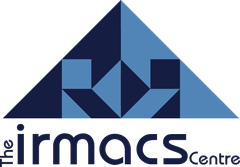2011 Abstracts
Looking for lost genomes
Cedric Chauve, SFU
Paleogenomics aims at reconstructing the genomes of extinct species, whose DNA can not be sequenced due to molecular decay. Hence the only possible approach is the study of current genomes (i.e. descendants of these extinct species) to detect conserved features that might indicate ancestral genomic characters and then to assemble these characters into ancestral genomes. Although the initial question is clearly biological, it can only be answered through an inference process that relies on both a mathematical model for ancient genomes and computational methods within this model. In this talk, I will present recent results on this problem, that rely on relatively old combinatorial notions such as the Consecutive Ones Property of binary matrices and PQ-trees.
Viral load in treated HIV+ individuals modeled using branching processes
Jessica Conway, UBC
I will discuss a stochastic model of within-host HIV viral dynamics. The modeling is motivated by observations of viral load in HIV+ patients on anti-retroviral treatment: though the treatment very effectively inhibits viral replication, a treated HIV+ individual's viral load remains non-zero. Further, blood tests show occasional "viral blips," short periods of increased viral load. We adopt the hypothesis that this low viral load can be attributed to activation of cells latently infected by HIV before treatment initiation. Blips would then represent small-probability deviations from the mean. Modeling this system as a branching process, we compute probability distributions for viral load using a novel numerical approach. These distributions yield blip amplitudes consistent with patient data. We then compute probability distributions on duration of these blips through direct numerical simulation. Our stochastic model of latent cell activation reproduces features of treated HIV infection, and can be used to provide insight into variability of treatment outcomes for HIV+ individuals not available in deterministic models.
Homomorphisms to Clebsch, proof by computer
Matt DeVos, SFU
Computer proofs are nothing new in graph theory... after all our most famous theorem, the Four Colour Theorem, was proved by a computer 35 years ago. I will discuss this and other computer proofs in graph theory, then detail a recent contribution of this type due to Robert Samal and myself. We give a computer proof that every cubic graph of girth at least 17 has a homomorphism to the Clebsch Graph.
Searching for a maximum set of mutually orthogonal Latin squares of order 10
Wendy Myrvold, UVic
A Latin square of order n is a n×n array of n symbols such that each symbol appears exactly once in each row and exactly once in each column. Two Latin squares of order n are orthogonal if, when superimposed, each ordered pair of symbols occurs exactly once. One of the big unsolved problems in design theory is to determine if it is possible to find three or more pairwise orthogonal Latin squares of order 10. This talk describes both theoretical and computational attempts at resolving this question. The talk will conclude with some suggestions for promising areas for continued search.
The research presented in this talk was done in collaboration with Russell Campbell, Erin Delisle, Mark Ellingham, Leah Howard, Nikolay Korovaiko, Brendan McKay, Alison Meynert, and Ian Wanless.
Discrete geometric game interpretations of nonlinear elliptic partial differential equations
Adam Oberman, SFU
In this mostly nontechnical talk, I will present discrete geometric games, which in simple cases you will be able to solve on a blackboard. Starting with familiar games, such as random walks, we will add new twists (choosing biased diffusions, exit strategies, random turns).
These games lead to interpretations and effective solution methods for nonlinear partial differential equations which appear in areas such as: Differential Geometry, Stochastic Control, Mathematical Finance, and Homogenization. Typical examples include: Hamilton-Jacobi equations, the Monge-Ampere equation, and the equation for the Convex Envelope.

